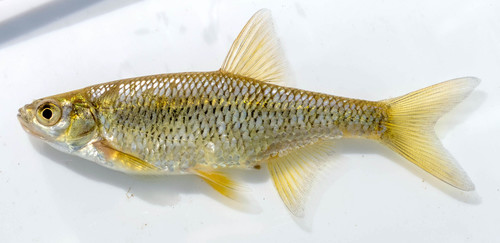
Golden Shiner
The Atlantic Bluefin Tuna (Thunnus thynnus) is a magnificent and highly migratory species of tuna found in the Atlantic Ocean. Renowned for its size, speed, and commercial value, it plays a crucial role in marine ecosystems and human economies, particularly in the sushi industry.
1 9 years
Lifespan
7.6 - 12.7 cm
Length
Least Concern
Conservation Status
null km/h
Swimming speed
Omnivorous, Planktivorous, Insectivorous
Diet
Local Migration
Migration
Appearance Overview
The Atlantic Bluefin Tuna is a large, torpedo-shaped fish with a metallic blue-black back and a silvery-white belly.
Coloration
Dark metallic blue on top, silvery-white underside
Body Shape
Torpedo-shaped, streamlined
Fins
Two dorsal fins, the first depressible; small finlets running from dorsal and anal fins to the tail
Keel
Strong lateral keel on the caudal peduncle
Length
Up to 13 feet (4 meters)
Weight
Up to 2,000 lbs (907 kg)
Diet
Carnivorous, feeding on a variety of fish, squid, crustaceans, and eels.
Feeding Behavior
Highly active predator, using speed and agility to hunt; often feeds cooperatively, herding and trapping prey.
Social Behavior
Forms large schools, often segregated by size; highly migratory, capable of trans-Atlantic crossings.
Commercial Relevance
Extremely high value, particularly in sushi and sashimi markets; one of the most expensive fish in the world.
Conservation measures
Subject to international fishing quotas, stock management plans, and monitoring efforts; some marine protected areas.
Status
Western Atlantic stock: Endangered; Eastern Atlantic and Mediterranean stock: Near Threatened
Threats
Overfishing (historically and ongoing in some areas), bycatch in fishing gear, habitat degradation, climate change.
Habitat Distribution
Depth Range
0-1,000 meters (typically in surface to epipelagic zones)
Geographic Range
Western and Eastern Atlantic Ocean, Mediterranean Sea, and formerly the Black Sea.
Preferred Environment
Temperate and subtropical waters; pelagic, open ocean environments, but also coastal areas during certain seasons.
Reproduction and Life Cycle
Breeding Habits
Spawns in warm waters; two main spawning grounds: the Mediterranean Sea and the Gulf of Mexico. Spawning occurs in spring and summer.
Development Stages
Eggs are pelagic and hatch into larvae; rapid growth in the first year; juveniles form schools and gradually mature.
Fecundity
Females are highly fecund, capable of releasing up to 30 million eggs per spawning season.
Maturity Age
Maturity age varies by location: Western Atlantic stock matures at around 8-12 years, Eastern Atlantic stock at around 4-5 years.
Faqs about Golden Shiner
How long do Atlantic Bluefin Tuna live?
Atlantic Bluefin Tuna can live up to 40 years.
How fast can Atlantic Bluefin Tuna swim?
They are among the fastest fish, capable of bursts of speed up to 40-60 mph.
Are Atlantic Bluefin Tuna warm-blooded?
Yes, they are warm-blooded, able to maintain a body temperature higher than the surrounding water.
How far do Atlantic Bluefin Tuna migrate?
They undertake extensive migrations for feeding and spawning, sometimes crossing entire oceans.
Why is Bluefin Tuna so expensive?
The high demand, particularly from Japan, and the limited supply drive up the price.
Where are Atlantic bluefin tuna found?
They are primarily found in the Atlantic Ocean, including the Mediterranean Sea.
Are bluefin tuna warm or cold blooded?
Bluefin tuna are warm-blooded, which helps them survive in a wide range of water temperatures.
How deep can bluefin tuna dive?
Bluefin tuna can dive to depths of over 3,000 feet.
What is the biggest bluefin tuna ever caught?
The biggest bluefin tuna ever caught weighed 1,496 pounds.
Copyright @ Nature Style Limited. All Rights Reserved.
 English
English